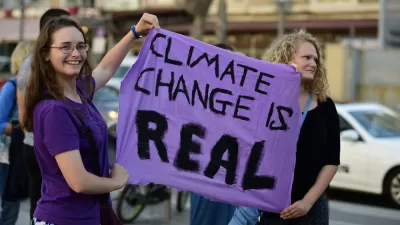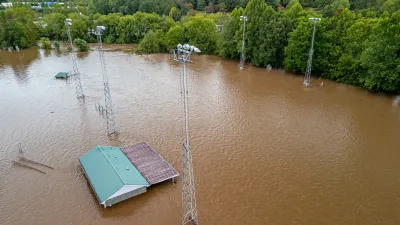Though the need for resilient communities is obvious, exactly how to measure resilience is less obvious. Edward J. Jepson, Jr. provides a new metric of the evidence of a community's resilience and produces a corresponding ranking of 30 U.S. cities.

As recognition of communities as complex systems becomes increasingly widespread and established in the planning profession, the concept of resilience is emerging as a major topic of interest and discussion among planners. So far, attention has focused on how the concept of resilience, as it has been characterized for non-human systems, can be translated for application to human systems (e.g., Pendall et al. 2009). Here, I present a new index for measuring the progress of communities in becoming more resilient.
Resilience is generally recognized as the ability of a complex system to adapt to change. This definition can be further refined as the ability of a complex system to maintain its integrity by responding successfully to threatening disturbances—either in the form of singular shocks or ongoing stresses.
As complex systems, human communities can be studied in terms of their resilience. Most of the planning and development literature focuses on the systemic characteristics and capacities thatcontributeto a community's resilience. These include the following:
- Self-organizing (semi-autonomy, inclusivity)
- Visioning/anticipatory
- Collaborative (formal and informal institutional networking)
- Entrepreneurial/innovative
- Self-critical/self-correcting
- Knowledge-building (as a result of experimentation and with respect to communities as complex systems)
- Diverse in terms of function and response [1]
The Resilience Capacity Index provides an example of the use of these types of characteristics and capacities to measure community resilience. The Rockefeller Foundation is also developing an index derived from a detailed and extensive framework that includes community engagement, leadership, and other contributing factors.
A different approach to studying resilience would be to evaluate communities in terms of evidence of their resilience. Instead of their inputs to resilience (i.e., the systemic characteristics that have the potential to contribute to a community's resilience), this different approach would measure resilience as output, that is, the outcome produced by such characteristics. Thus, the two approaches are complementary: when used together they have the potential to increase our understanding of both.
Such an approach would require the identification of core functional requirements that qualify a community as a system, such as employment opportunities and safety. These may be viewed as core because their absence or degradation would make it more difficult for the community and its residents to provide and enjoy such benefits as recreational and cultural amenities. In essence, then, the presence of employment opportunities and a safe environment are necessary for a community to function successfully as a system. Conversely, their absence is evidence of systemic dysfunction and the need for new actions or even a transformation of the existing system.
Simply providing these core functions does not ensure a community's success as a system. A community system is also defined in terms of a variety of "non-core" functions, such as recreational and cultural amenities. The presence of "core" functions suggests only that a community has the capacity to provide these other "non-core" functions, not necessarily that it will. For many people, the availability and quality of these types of functions influences their decision about where to live. Because people are the key agents in community systems, a community's ability to attract and retain residents can then be viewed as additional evidence of its success as a system.
On the basis of these considerations, unemployment rate, violent crime rate, and population change can be identified as key characteristics that reflect and determine a community's condition of resilience, i.e., one that reflects effective response to the numerous economic, environmental, and social stresses that it encounters on a regular and ongoing basis.
I propose a resilience indicator that combines measurement of unemployment, violent crime, and population in terms of their variability, magnitude, and trend over time.[2] Calculating this indicator for 30 U.S. cities resulted in the ranking contained in the table below, organizing cities from low to high, with the lowest score corresponding to high resilience.[3] Austin, Texas ranked as the most resilient city in the group, and Detroit, Michigan ranked as the least resilient.
Resilience Rank for 30 U.S. Cities
|
Rank |
City |
Resilience Indicator* |
|
1 |
Austin, TX |
1.49 |
|
2 |
San Antonio, TX |
1.90 |
|
3 |
New York, NY |
2.01 |
|
4 |
Portland, OR |
2.09 |
|
5 |
Ann Arbor, MI |
2.22 |
|
6 |
Madison, WI |
2.33 |
|
7 |
Raleigh, NC |
2.34 |
|
8 |
Des Moines, IA |
2.37 |
|
9 |
Boston, MA |
2.38 |
|
10 |
Denver, CO |
2.39 |
|
11 |
Erie, PA |
2.45 |
|
12 |
Knoxville, TN |
2.61 |
|
13 |
Minneapolis, MN |
2.73 |
|
14 |
Miami, FL |
2.75 |
|
15 |
Los Angeles, CA |
2.85 |
|
16 |
New Orleans, LA |
2.95 |
|
17 |
Kansas City, MO |
3.04 |
|
18 |
Pittsburgh, PA |
3.05 |
|
19 |
Atlanta, GA |
3.07 |
|
20 |
Nashville, TN |
3.19 |
|
21 |
Youngstown, OH |
3.30 |
|
22 |
Buffalo, NY |
3.44 |
|
23 |
Birmingham, AL |
3.54 |
|
24 |
Cleveland, OH |
3.57 |
|
25 |
Indianapolis, IN |
4.03 |
|
26 |
Milwaukee, WI |
4.10 |
|
27 |
Las Vegas, NV |
4.23 |
|
28 |
Philadelphia, PA |
4.26 |
|
29 |
Memphis, TN |
5.38 |
|
30 |
Detroit, MI |
5.45 |
*Indicator value is inversely associated with level of resilience.
It is important to note that such an indicator does not measure a community's sustainability. While many adaptations make a community more sustainable and resilient—such as bike lanes or low-income, energy-efficient housing—there are many others that would not have that combined effect. For example, the introduction of a new pesticide may reverse declining agricultural production but still contaminate the environment. Or while the construction of a new road may respond to changing traffic conditions, it will also cause environmental damage. As brilliantly analyzed and pointed out by Derissen et al. (2011), there are many factors that determine whether a resilient system is also a sustainable one.[4]
The value of a resilience indicator such as the one proposed is proven when communities compare themselves with other communities that score higher, focusing on the input characteristics and capacities that have been identified in the literature. For example, a low-scoring community may be motivated to evaluate its community engagement mechanisms compared to those of a higher-scoring peer community. A resilience indicator of this kind would also make possible measurement of the extent to which changes to such inputs—through direct policy and organizational interventions—produce effects in a community's resilience over time.
As a property of sustainable systems, resilience is an important community development concept. An indicator such as the one proposed here can be applied to all communities, rather than just those that have experienced a significant shock. This being the case, it can serve as a basis for systemic improvement among all communities, as well as the academic study of the capacities that are theorized to contribute to resilience and, by extension, sustainability.
Edward J. Jepson, Jr. is an adjunct professor of planning and planning consultant living in Knoxville, Tennessee. For information about how the resilience index is calculated, he can be contacted at [email protected].
Sources
Booher, D.E. and J.E. Innes. 2010. Governance for resilience: CAFED as a complex adaptive network for resource management. Ecology and Society 15(3): 35 (online).
Bristow, G. 2010. Resilient regions: re-'place'ing regional competitiveness. Cambridge Journal of Regions, Economy and Society 3(1): 153-167.
Derissen, S., M. F. Quaas, and S. Baumgartner. 2011. The relationship between resilience and sustainability of ecological-economic systems. Ecological Economics 70(6): 1121-1128.
Elmqvist, T. 2013. Urban sustainability and resilience: why we need to focus on scales. The Nature of Cities. Available at http://www.thenatureofcities.com/2013/03/27/urban-sustainability-and-re….
Folke, C., S. Carpenter, T. Elmqvist, L. Gunderson, C.S. Hollling, and B. Walker. 2002. Resilience and sustainable development: building adaptive capacity in a world of transformations. Ambio 31(5): 437-440.
Folke, C., T. Hahn, P. Olsson, and J. Norberg. 2005. Adaptive governance of social-ecological systems. Annual Review of Environment and Resources 30: 441-473.
Folke, C. 2006. Resilience: the emergence of a perspective for social-ecological systems analysis. Global Environmental Change 16(3): 253-267.
Holling, C.S., L.H. Gunderson, & G.D. Peterson. 2002. Sustainability and panarchies. In Panarchy: Understanding transformations in human and natural systems. In L.H. Gunderson & C.S. Holling, eds. Washington, D.C.: Island Press.
Maddox, D. 2013. The cities we want: Resilient, sustainable and livable. The Nature of Cities. Available at http://www.thenatureofcities.com/2013/05/08/the-cities-we-want-resilien….
Norris, F., S. Stevens, B. Pfefferbaum, K. Wyche, and R. Pfefferbaum. 2008. Community resilience as a metaphor, theory, set of capacities, and strategy for disaster readiness. American Journal of Community Psychology, 41(1-2): 127-150.
Pendall, R., K.A. Foster, and M. Cowell. 2009. Resilience and regions: Building understanding of the metaphor. Cambridge Journal of Regions: Economy and Society 3(1): 1-14.
Redman, C.L. 2014. Should sustainability and resilience be combined or remain distinct pursuits? Ecology and Society 19, 2: 37. Available at http://www.ecologyandsociety.org/vol19/iss2/art37.
Walker, B. and D. Salt. 2006. Resilience thinking: Sustaining ecosystems and people in a changing world. Washington, D.C.: Island Press.
Webb, C.T. 2007. What is the role of ecology in understanding ecosystem resilience? Bioscience 57(6): 470-471.
Wilkinson, C. 2011. Social-ecological resilience: Insights and issues for planning theory. Planning Theory 11(2): 148-169.
Notes
[1] Functional diversity is reflected in doing different things, response diversity is reflected in doing things differently.
[2] The formula for calculating the resilience index can be obtained by contacting the author at [email protected].
[3] The 30 cities were not randomly selected, and the results are not intended to be representative of U.S. cities generally.
[4] For more discussion of the relationship between resilience and sustainability see Elmqvist, 2013; Maddox, 2013; Redman, 2014.

Maui's Vacation Rental Debate Turns Ugly
Verbal attacks, misinformation campaigns and fistfights plague a high-stakes debate to convert thousands of vacation rentals into long-term housing.

Planetizen Federal Action Tracker
A weekly monitor of how Trump’s orders and actions are impacting planners and planning in America.

San Francisco Suspends Traffic Calming Amidst Record Deaths
Citing “a challenging fiscal landscape,” the city will cease the program on the heels of 42 traffic deaths, including 24 pedestrians.

Defunct Pittsburgh Power Plant to Become Residential Tower
A decommissioned steam heat plant will be redeveloped into almost 100 affordable housing units.

Trump Prompts Restructuring of Transportation Research Board in “Unprecedented Overreach”
The TRB has eliminated more than half of its committees including those focused on climate, equity, and cities.

Amtrak Rolls Out New Orleans to Alabama “Mardi Gras” Train
The new service will operate morning and evening departures between Mobile and New Orleans.
Urban Design for Planners 1: Software Tools
This six-course series explores essential urban design concepts using open source software and equips planners with the tools they need to participate fully in the urban design process.
Planning for Universal Design
Learn the tools for implementing Universal Design in planning regulations.
Heyer Gruel & Associates PA
JM Goldson LLC
Custer County Colorado
City of Camden Redevelopment Agency
City of Astoria
Transportation Research & Education Center (TREC) at Portland State University
Jefferson Parish Government
Camden Redevelopment Agency
City of Claremont





























